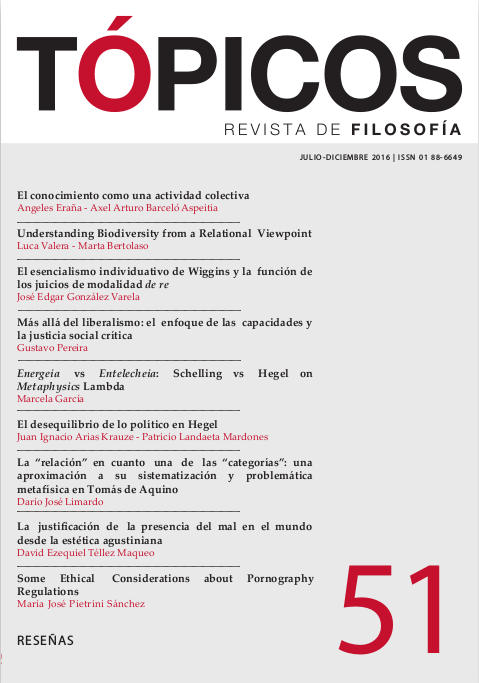La “relación” en cuanto una de las “categorías”: una aproximación a su sistematización y problemática metafísica en Tomás de Aquino
Publicado 2016-07-01
Palabras clave
- relación,
- categorías,
- inherencia,
- accidentes,
- metafísica
- Tomás de Aquino ...Más
Cómo citar
Resumen
La “relación” en Tomás de Aquino es una de las “categorías” aristotélicas que representan “accidentes”. No obstante, tal compromiso metafísico conlleva algunas dificultades ya que el esquema “sustancia”-“accidentes” no deja lugar a la idea de un “término medio” entre dos cosas. En este artículo presento algunas tensiones entre la sistematización de la “relación” como categoría en Tomás de Aquino y su posición sobre el “estatus” de los predicamentos en general. Para ello analizo primero la deducción de las categorías tal como es presentada por el autor para luego abordar la “relación” de modo sistemático. En esta exposición argumento que Tomás tiene severas dificultades para asignarle un “fundamento accidental propio” distinto al de los otros predicamentos que le permita considerarla una de las “categorías”.
Referencias
- Bibliografía primaria
- Thomae Aquinatis. (1992). Opera Omnia cum Hypertextibus in CD-ROM. Busa, R. (ed.). Milano: Editoria Elettronica Editel.
- ____ (1929) Scriptum super libros Sententiarum magistri Petri Lombardi episcopi Parisiensis. t. 1. Mandonnet, P. (ed.), Paris: P. Lethielleux.
- Bibliografía secundaria
- Ackrill, J. (1963). Aristotle’s Categories and De Interpretatione. Oxford: Clarendon Press.
- Alarcon, E. (1999). El principio de contradicción y la estructura del ente en Aristóteles. Acta Philosophica VIII-2, 271-277.
- Ashworth, E. (2008). Les théories de l’analogie du XIIe au XVIe siècle. Paris: Vrin.
- Aristóteles. (2000). Metafísica. Calvo Martínez, T. (Trad.) Madrid: Biblioteca Básica Gredos.
- ____ (2007). Tratados de Lógica (Órganon). Candel Sanmartín, M. (Trad.) Madrid: Biblioteca Gredos.
- Bobik, J. (2004). Aquinas on Being and Essence. A translation and Interpretation. Notre Dame: University of Notre Dame Press.
- Brower, J. (1998). Abelard Theory of Relations: Reductionism and the Aristotelian Tradition. Review of Metaphysics LI, 605-631.
- ____ (2014). Medieval Theories of Relations. The Stanford Encyclopedia of Philosophy. E. N. Zalta (Ed.) <http://plato.stanford.edu/archives/ spr2014/entries/relations-medieval/>
- Doolan, T. (2014). Aquinas on the Metaphysician’s vs. the Logician’s Categories. Quaestiones Disputatae IV-2, 133-155.
- Gracia, J. (2003). ¿Qué son las categorías? Ingala, E. (Trad.). Madrid: Ediciones Encuentro.
- Henninger, M. (1989). Relations: Medieval Theories 1250-1325. Oxford: Clarendon Press.
- Hood, P. (2004). Aristotle on the Category of Relation. Lanham, MD: University Press of America.
- Irwin, T. (1981). Homonymy in Aristotle. Review of Metaphysics XXXIV-3, 523-544.
- Krempel, A. (1952). La Doctrine de la Relation chez Saint Thomas. Exposé historique et systématique. Paris: Librarie Philosophique J. Vrin.
- Klima, G. (2002). Aquinas’ Theory of the Copula and the Analogy of Being. Logical Analysis and History of Philosophy V, 159-176.
- McInerny, R. (1996). Aquinas and analogy. Washington: Catholic University of America Press.
- Owen, G. (1986). Logic and Metaphysics in Some Early Works of Aristotle. En Logic, Science, and Dialectic. Collected Papers in Greek Philosophy. Nussbaum, M. (Ed.) (180-200). Ithaca-New York: Cornell University Press.
- Pini, G. (2002). Categories and Logic in Duns Scotus. Leiden-Boston Köln: Brill.
- ____ (2005). Scotus’s Realist Conception of the Categories: His Legacy to Late Medieval Debates. Vivarium LXIII-1, 63-110.
- Schmidt, R. (1966). The Domain of Logic According to Saint Thomas Aquinas. The Hague: Martinus Nijhoff.
- Tomarchio, J. (2001). Aquinas Division of Being According to Modes of Existing. The Review of Metaphysics LIV-3, 585-613.
- Ventimiglia, G. (1997). Differenza e contraddizione. Il problema dell’essere in Tommaso d’Aquino: esse, diversum, contradiction. Milano: Vita e Pensiero.
- Ward, J. (2008). Aristotle on Homonymy (Dialectic and Science). Cambridge: Cambridge University Press.
- Ward, T. (2010). Relations Without Forms: Some Consequences of Aquinas’s Metaphysics of Relations. Vivarium LXVIII, 1-23.
- Wippel, J. (1987). Thomas Aquinas’s Derivation of the Aristotelian Categories (Predicaments). Journal of the History of Philosophy XXV, 13-34.
- ____ (2007). The Metaphysical Thought of Thomas Aquinas. Washington D.C.: The Catholic University of America Press.






